Map
Eco-museum of the Upper Garfagnana
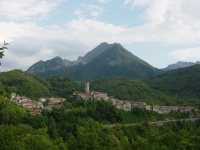
This definition, which is the most common, says all that is Eco-museum of the Upper Garfagnana.
It is an instrument consisting of cultural itineraries that show the identity of this land: routes of the "Liguri Apuani", of the Middle Ages, castles, country culture, along which are located these museums and archaeological parks:
- Museum of the Identity of the Upper Garfagnana "Olinto Cammelli" (Gorfigliano, Old Church),
- Archaeological Park of the Ospitale (Mountain hut, refuge) of St. Nicholas of Tea (near Mount Argegna),
- Tower of Pugliano,
- Castle and Ghost Village of Bergiola,
- Sanctuary of the Statue Stele (Hermitage of Minucciano or Hermitage of the "Beata Vergine del Soccorso").
- Where is it.
The Castle of Gorfigliano and Museum of the Identity of the Upper Garfagnana "Olinto Cammelli" (Gorfigliano).
The hill on which the old church has probably seen the eighth century, the birth of a village peasant from the Lombard period.
The village appears to be related to the growth of the cultivation of new chestnut.
In 997, the documented existence of a castle of Cunimodinguna, powerful local lords ruling the territory that is centered around their castle.
In the seventh century, the phase of maximum expansion of the power of these Lords, the castle was enlarged with the construction of walls and the tower became, in 1762, the bell tower still visible on the top of the hill.
In this phase had to be built also the church of Saints Giusto and Clemente, quoted in the seventh century.
The village grew around the tower along the sides of the fortified hill.
Then arose another settlement in the below valley of the Acqua Bianca called "huts of Gorfigliano".
The castle was then still under the domination of Lucca, while in the religious, the church of San Giusto and San Clemente belonged to the Diocese of Luni, heavily damaged in the earthquake of 1920, and subsequent killing, church and village were abandoned.
In recent decades, the complex of the old church was renovated by the work of volunteers of Gorfigliano and Verrucolette.
To these volunteers were dedicated, the Museum of Identity, of the Upper Garfagnana "Olinto Cammelli" which today is home to the Parsonage.
It originates from the donation of the collection of objects of life and farming and quarrying created by Olinto Cammelli, one of the most famous among those who have been called "the heroes of the old church."
The museum aims to capture and communicate the identity of the people of Upper Garfagnana.
The Archaeological Park of the Ospitale (Mountain hut, refuge) of St. Nicholas of Tea (near Mount Argegna).
If in winter, a pilgrim to Rome or to Santiago de Compostela or a merchant of Lucca, direct to the port of Genova or to the Po towns, they wanted to cross the step of Tea, would have little chance of success if there had not been the refuge of St. Nicholas, who according to legend founded by Matilde di Canossa where to find shelter in the night or in the storm.
And, at night, would not have reached if they had not heard the bell rang to call the lost hikers.
However, originally it was only a small church with an apse in a room adjoining.
It was another world: the time of Matilda, when built, the eleventh century, bridges, hospitals, roads along which cults were born and the many legendary stories to fuel the spirit of the Europeans.
Along those streets, in fact, Goethe said that Europe was formed.
From the thirteenth century shaman, by this step, especially the merchants, the carriers.
To protect them and their goods, they built the Ospitali places of refuge and refreshment.
After the downfall of the first building of the eleventh century, in Tea, in the thirteenth century, new demands, this time more related to commerce between Lucca and Genova, imposed to rebuild a larger Ospitale on many levels where they could find shelter goods, livestock, and travelers.
And it grew again in '400, demonstrating the considerable traffic.
Then, with the '500, began its decline and, at the end of that century, was already a ruin.
Since 1996 a series of excavations, directed by J. Antonio Quiros Castillo, brought to light the Ospitale.
The castle and the medieval tower ("il torrione") of Pugliano.
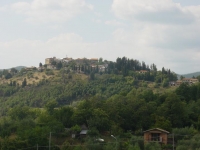
In middle age he was of noble Gragnana, which became, here the "Nobles of Pugliano".
Its church, dedicated to St. James, is a Romanesque church and is documented in the tenth end of the thirteenth century as a chapel of the Pieve di San Lorenzo di Vinacciara in the Diocese of Luni.
He was placed on the path that from Casola, leading to the Garfagnana and Lucca, in the way of the Holy Face (Volto Santo), the main variant of the Via Francigena.
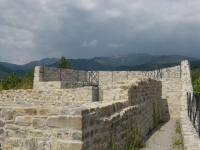
He went then to be part of the influence of the Marquis Malaspina, and then by Lucchesi, a castle of the "Land of Oltregiogo" (with Albiano, Sermezzana, Bergiola, Casola, Metra, Renzano, Novella, Pieve San Lorenzo).
In 300, passed several times under the rule in the hands of various rulers, from the Malaspina, Lucca, Florence, sharing the fate of Bergiola and other castles.
In the early 70s of 300, broke the "rebellion", led by Cecchinetto, of the nobles of Pugliano.
Giovanni Sercambi in its fourteenth-century criticism, drawing the documents the rebel castles.
About this episode exist a document describing the work to be done in the castle, referring to a "great tower" to be restored, which could be the polygonal tower popularly known as "il Turi�n" (the tower), but this construction could be also called the building, in the document, "Palasso of Dinello".
Pugliano was reconquered in 1373, from Lucca which was, de facto, forever, even with ups and downs.
The castle and the ghost village Bergiola.
The castle of Bergiola was, politically, in the Garfagnana, but the religious sphere, belonged to the Diocese of Luni.
He was placed in a strategic position between Garfagnana and Lunigiana, along a route of the Holy Face (Volto Santo), the main variant of the Via Francigena, which connected along the Garfagnana, Lunigiana with Lucca.
It was one of those fortifications, the kind that people of Lucca called the land of "Terre di Otre Giogo" because they are situated over the passage of Tea and Minucciano.
They were compact territorial entity, which joined in the Parish of San Lorenzo, Casola, Bergiola, Pugliano, Albiano, Renzano, Novella, Metra and Sermezzana.
In 1308, Bergiola is member of Lucca and is one of the castles required to bring a candle for the feast of the Santa Croce (Holy Cross). In 1313 Henry VII, grant it to Spinetta Malaspina, together with other municipalities in the parish church of San Lorenzo.
In 1319 is involved in the wars between Spinetta and the lord of Lucca, Castruccio Castracani of the Antelminelli that reconquest it.
On the death of Castruccio, it back to Malaspina but in the late 60's of 300 and, again, Lucca.
In 1373, a revolt led by Cecchinetto the Nobles of Pugliano against the domination of Lucca, but Lucca sends a military expedition and recapture the lost castles.
When, in 1496, Casola is undergoing in Florence, it breaks the unity of the lands of Oltregiogo and Bergiola became the last outpost of Lucca, adjacent to Florence.
The earthquake of 1920 and, even more, the depopulation of the Second World PostWar, determine its abandonment and the charm of a castle / ghost village.
The Archaeological Park of Statue Stele (Hermitage of Minucciano, Hermitage of Beata Vergine del Soccorso).
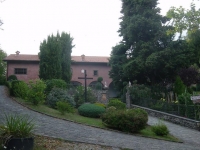
Here Augusto Cesare Ambrosi found three Statue Stele, the mysterious symbols of the Lunigiana.
It was on the border of an area, along a road that, coming from the sea, climbed the steps between Lunigiana and Garfagnana and toward the Po Valley and here our earliest ancestors wanted to create a sacred place, as was the centuries.
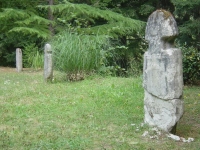
This part of the Upper Aulella Valley, already in control of Lucca, was considerably settled in the age of metals: the castles of Renzano and Pugliano, the settlement of Codiponte, the sanctuary of Minucciano, a place where a fourth Statue Stele was found not very away from the Hermitage, they speak of the pastoral communities of transhumance and trade with the peoples of the plains, including the Etruscans.
Vitality of the mountain, linked to roads, since then, linking places of the sea with the Po Valley.
In the faces of the enigmatic "Statue Stele", which evoke them, to some form of helmet popular in antiquity (with a strong protection of the nose and the roof of the mouth), is the depth of a story that we invite you to know; also among the places of the Eco-museum of the Upper Garfagnana.
Is an invitation to come in, slowly and with respect to the places, between the houses, among people who will welcome you as they did for thousands of years with the travelers ...
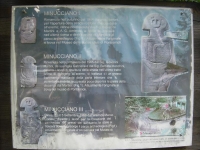
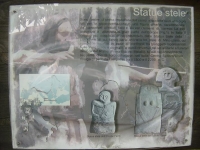
Link:
Museum of the "Statue Stele": statuestele.org
valeria.martini.name/Minucciano Santuario.htm
Where is it: Minucciano
Eco-museum: to visit the Eco-Museum always ask first to the Municipality of Minucciano, Department of Culture, 0583610392 segreteria@comunediminucciano.it
Reference of Municipality of Minucciano: comuni-italiani.it/046/019/amm.html
Museum of the Identity of the Upper Garfagnana "Olinto Cammelli"
also ask to Associazione Culturale Paese Vecchio of Gorfigliano 3466310940 gorfigliano@gmail.com